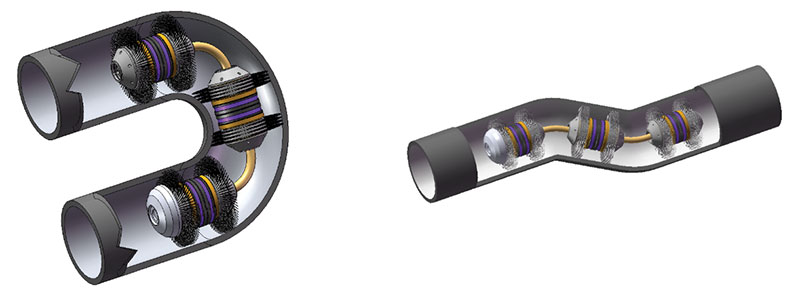October 2020, Vol. 247, No. 10
Tech Notes
Overcoming Challenges of Pigging the “Unpiggable”
By Chinedu Oragwu, Technical Advisor, Quest Integrity, Nigeria
The need to manage and maintain pipeline system integrity has become increasingly important to operators in recent years. Accurate measurement and evaluation of the physical condition of oil and gas pipelines is critical to effective integrity management, as well as to the assurance of sustained pipeline safety.
Conventional inline inspection tools are frequently used to perform detailed inspections on pipelines. These tools are not designed for use on all pipelines; however, lack of pigging facilities, bore restrictions, tight bend radii, varying pipeline diameters or flow restrictions can deem a pipeline “unpiggable” if the inspection tool cannot physically pass through the line.
Until recently, little progress had been made in development of pigs for these circumstances, and consequently, a large amount of piping, particularly within the fence line of refineries and other process plants, remained inaccessible.
Quest Integrity used its advanced ultrasonic inline inspection tool, designed to overcome challenges associated with pipeline configurations that until now have limited traditional pigging systems. InVista enables pipeline operators to gather highly accurate, quantifiable inspection data on nontraditional pipeline configurations. These data are used not only to identify corrosion and other defects, but also to provide a solid foundation for fitness-for-service (FFS) assessments.
The custom ultrasonic inline inspection technology is a lightweight, self-contained and bidirectional tool that provides absolute coverage of geometry and metal loss features.
Project Overview
Quest Integrity has recently completed the ultrasonic inline inspection of four traditionally unpiggable pipelines for a major operator in West Africa. The pipelines that were constructed in the mid-1990’s had never been pigged due to the lack of pigging facilities and challenging configurations. Prior to the inspection activities, the pipelines were taken out of service for temporary pig traps installation.
The pigging was carried via auxiliary pumping with chemically treated creek water. The inspections were required to detect and quantify remaining wall thickness, internal and external metal loss, and deformations ensuring they were FFS because any unplanned downtime would severely hamper production.
The pipes inspected were designed to carry oil from well heads to production platforms and measured 12 inches (305 mm), 1.8 miles (2.9 km); 12 inches, 1.5 miles (2.4 km); and 10 inches (254 mm), 0.15 miles (0.24 km).
The pipelines had dual diameters with unknown inner diameter (ID) restrictions. The 12-inch pipelines contained 10-inch portions of pipe, and the 10-inch pipeline contained 8-inch (203-mm) portions of pipe. In addition, there was the presence of unknown ID restrictions and short radius bends.
A two-man team mobilized offshore to inspect the four pipelines: Prior to the inspection, pipelines were cleaned using a progressive nonaggressive pigging program.
The InVista inspection tool was launched and, upon retrieval, the ultrasonic testing (UT) measurement data was downloaded and prepared for initial field analysis. Within hours after the inspection, the customer was presented a site completion report indicating data quality, pipeline cleanliness and location(s) of debris. A Level 2 FFS final report was delivered in accordance with API 579 to the client within 45 days.
Conclusion
The technology overcomes challenges associated with traditionally difficult-to-inspect or unpiggable pipelines. The inspection delivered 100% axial and circumferential ultrasonic wall thickness measurements, as well as geometry data.
Some of the benefits the client noted were as follows:
- Improved safety and flexibility: Tools are extremely lightweight and short; no lifting equipment was required.
- Simplified inspection process: High-resolution ultrasonic sensors acquire direct measurements providing geometry and wall thickness data in a single inspection run; no gauging and caliper pigging is required.
- 30% local collapsibility: The collapsible design allows for full navigation of pipeline with a reduced local cross section up to 30%.
- Reduced operational risk is provided through low-friction, neutrally buoyant, untethered and bi-directional applications.






Comments